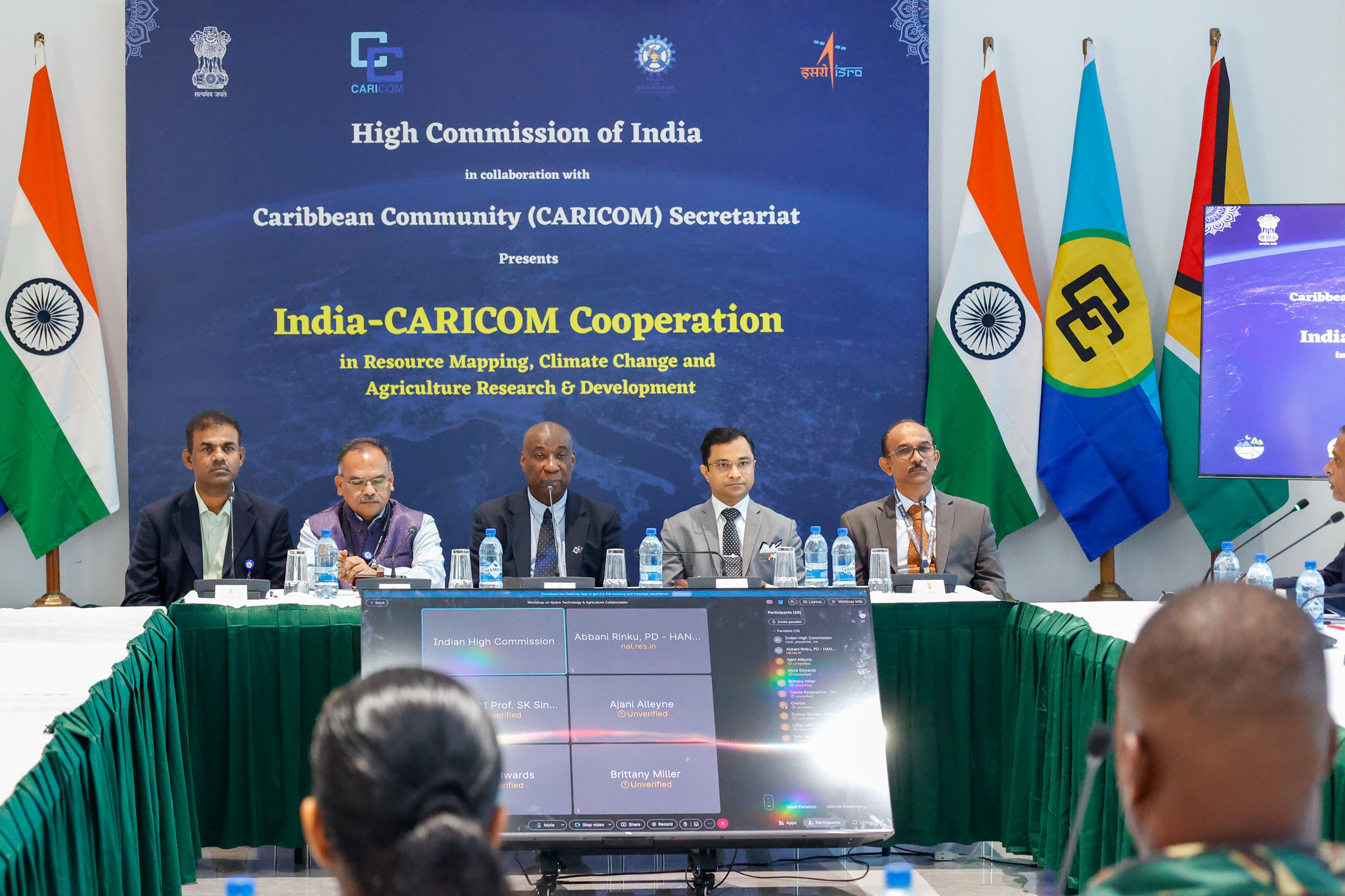(Caribbean Community (CARICOM) Secretariat, Turkeyen Greater Georgetown, Guyana) – The Caribbean Community (CARICOM) and the Republic of India continue to deepen cooperation under the partnership elaborated at the Second CARICOM-India Summit held in November 2024.
On Friday, 25 July, the Indian High Commission in collaboration with the CARICOM Secretariat convened a high-level seminar on space technology in Georgetown, Guyana. The event brought together representatives from CARICOM Member States, the CARICOM Secretariat, regional institutions, and the diplomatic community, both in person and online.
Speaking at the opening of the seminar, Dr. Wendell Samuel, Senior Economic Advisor and Acting Assistant Secretary-General of the Directorate of Innovation, Integration and Development, noted that the event marked a key milestone in the operationalisation of the seven-pillar cooperation framework outlined by the Prime Minister of India Shri Narendra Modi.
These pillars form the acronym CARICOM: Capacity Building, Agriculture and Food Security, Renewable Energy and Climate Change, Innovation and Technology, Cricket and Culture, Ocean Economy and Maritime Security, and Medicine and Healthcare.
Although the session focused primarily on Innovation and Technology, Dr. Samuel noted that the Indian Space Research Organisation’s (ISRO) wide-ranging applications intersect with several other priority areas for the Caribbean, including agriculture, climate resilience, renewable energy, and ocean governance.
Please see his full presentation below:
H.E. The Indian High Commissioner to Guyana.
Members of the Team from ISRO
Representatives of Member States,
Representatives of Regional Institutions,
Distinguish Participants (in person and online),
Colleagues all…
Good morning!
I would like to welcome you warmly to this seminar on space technology facilitated by the Indian Space Research Organization (ISRO).
It represents one more concrete step in the implementation of the programme of activities identified under the Bilateral Agreement between The Republic of India and CARICOM during the visit of Prime Minister Modi to Georgetown in November 2024. As many of you would recall, in a very thought-provoking and insightful speech, Prime Minister Modi laid out seven Key pillars of India-CARICOM cooperation that spelt out the acronym of CARICOM.
Just as a reminder, those 7 pillars were:
C: Capacity Building – Particularly in information technology to enhance digital skills in the Region
A: Agriculture and Food Security – India has developed specialised technology for small scale agriculture and is willing to share these with CARICOM
R: Renewable Energy and Climate Change – Assisting with the transition to renewable energy and fighting climate change
I: Innovation and Technology – India has revolutionised the way that technology is used to serve people. We will see some of these applications today
C: Cricket and Culture – This one is self-explanatory. It’s a good thing that it is self-explanatory because the less said about cricket these days the better.
O: Ocean Economy and Maritime Security – Harnessing the ocean and marine resources for the benefit of current and future generations.
M: Medicine and Healthcare – India’s is well known for its healthcare system and pharmaceutical industry.
We all recall, with gratitude, the major contribution that the Republic of India made to containing the spread COVID-19 in the region.
Today’s presentation, nominally, falls under Innovation and technology. But looking at the range of activities undertaken by the ISRO, the activities could fit under a number of these pillars including Agriculture and food security; Renewable energy and climate change; Ocean economy and Maritime security, to name a few.
So, let’s look a little closer:
Agriculture and food security
The Region is realising steady progress achieving greater food and nutrition security. The Caribbean Community has made it a priority to achieve the target of reducing food imports by 25 percent by 2025.
The regional food and nutrition security goals are focused on enhancing food security, increasing the sustainability of our food systems, and promoting resilience across our region. We know that these ambitious goals cannot be achieved without creativity, innovation, and significant investment by the public sector, private sector, and international partners.
The initiative has been recently extended to 2030 and is now referred to as 25 by 2025 +5. The extension allows us, inter alia, to build on the regional gains and goodwill which have been achieved so far, expanding the stakeholder base and participation in the initiative; greater involvement and investment from more of the regional private sector; further improvement in human capacity among farmers and the ministries of agriculture; and the complete removal of barriers to regional trade in agricultural products.
The increasing frequency and severity of weather-related events, makes the role of agriculture insurance critical in safeguarding the livelihoods of farmers and ensuring food and nutrition security. In addition, agricultural insurance offers the Region a shield against the unpredictable and devastating impacts of climate change on agriculture.
The tools offered by the ISRO for agriculture and crop monitoring would help achieve the 25 by 2025 goals. Similarly, the tools deployed under disaster management could help improve early warning systems and improve the speed and accuracy of the estimation of losses to support the introduction of more effective insurance products.
Renewable Energy and Climate Change
As Small Island Developing States, the effects of Climate Change looms as an existential threat to lives and livelihoods in these economies. During the past ten years the Caribbean has been affected by 40 tropical storms, of which 12 reached hurricane strength and 8 were classified as major hurricanes. They resulted in extensive flooding, landslides, damage to infrastructure and housing, dislocation, and loss of lives and property.
Six Caribbean States are ranked in the top ten of the most disaster-prone countries in the world. CARICOM Member States are all ranked in the 50 most affected countries, costing the region an average of 2% of GDP every year. 2025 is expected to be an active or even highly active hurricane season with 19 to 25 storms expected to develop, of which 7 to 11 are expected to become hurricanes and as many as 6 to be classified as intense hurricanes. The Region is taking measures to enhance its resilience to these more extreme events. Building codes are being revised and emergency centres and shelters are being retrofitted to these higher standards.
Early warning systems are being strengthened. However, critical infrastructure such as hospitals, utilities, roads, and bridges remains vulnerable to these extreme events.
Earlier on this year, there was great uncertainty about whether satellite data to monitor the progress of hurricanes as they come off the African coast would be available for this Hurricane Season. As the US Administration sought to determine the role of the National Oceanic and Atmospheric Administration, the prospect of a hurricane season without early warning seemed real. While the data continues to flow, the uncertainty generated by the knowledge that, what was normally taken for granted, could be shut off at the drop of a hat, gives cause for concern. In these circumstances, building redundancy is not only prudent but an absolute requirement.
The Caribbean produces most of its electricity through the combustion of fossil fuels. However, the Region is blessed with considerable renewable energy resources such as biomass, geothermal, hydro, ocean thermal, and wind. The Region’s use of renewable energy has more than doubled in the past 10 years. Still, renewable energy only accounts for about [12] percent of the energy mix.
It is therefore incumbent that the Region accelerates the transition to renewable energy for both economic and environmental reasons.
The devastation to energy infrastructure occasioned by the extreme events in the past ten years, provides an opportunity to accelerate this transition by building back better and smarter. This could provide the opportunity for public private partnerships in energy supply and distribution systems. In addition, it could facilitate demand side management by making water transmission and buildings greener and more energy efficient.
The disaster management and climate and weather applications of the ISRO would be useful in disaster risk reduction and identifying locations for renewable energy using wind and ocean resources.
Ocean Economy and Maritime Security
For CARICOM, the ocean is synonymous with our identity, our culture, and our survival. The ocean represents our most abundant resource making us large ocean states as opposed to small island states. It is our historical highway and our connection, our food basket, our playground, and, our life source. Our oceans supply 50% of the oxygen we breathe and is also a significant carbon sink in the fight against climate change. They sustain a rich biodiversity that is a natural heritage of the Caribbean Region.
The World Bank estimates the value of CARICOM’s Ocean Economy at about US$400 billion. This figure represents a vast, untapped potential to catalyze economic growth, create vital jobs, and foster social prosperity for all our citizens. Coastal tourism, fisheries, and aquaculture are key pillars for Caribbean economies. Tourism, for example, accounts for an estimated 50% of GDP in the Eastern Caribbean. The fisheries sector provides gainful employment for over 120,000 fishermen and supports thousands more indirectly. The sector remains a vital part of regional food and nutrition security. Its productivity and sustainability could be enhanced by innovation and technology.
Still, this invaluable resource is under unprecedented pressure. Oceans in our region face a complex array of challenges. Rising sea levels, ocean acidification, and increasingly intense hurricanes pose direct, existential risks to our coastal communities and ecosystems, as well as critical infrastructure that underpin our economies. The persistent influx of sargassum seaweed, for instance, has inflicted major economic damage on our vital tourism and fishing sectors. In addition, climate change, pollution, and overfishing are relentlessly degrading our marine ecosystems.
Increasingly, criminal activities on the open seas threaten the ability of Member States to control and benefit for the resources that abound in the Ocean. Organised international criminal activity diverts these benefits from their rightful owners to international criminal enterprises through illegal fishing and other activities with scant regard for conservation and sustainability.
The coastal and marine applications of the ISRO can help with coral reef monitoring and identification of potential fishing zones. Potential fishing zones forecasting will be a valuable tool to locate where migratory species are likely to be. The latter would be good news for the Barbadian fishermen to help predict whether flying fish are likely to be nearer to Barbados or Tobago during next flying fish season.
Colleagues, the possibilities for utilizing the applications of the ISRO in CARICOM are not endless, but as you might have gleaned from the foregoing, they are quite significant. So let me end here and hand over to the Team from the ISRO to provide more detail on these applications and their potential uses in CARICOM. I look forward to your active participation in the ensuing discussion. Hopefully, we can also identify some concrete initiatives that can be implemented presently.
Thank you for your attention.





